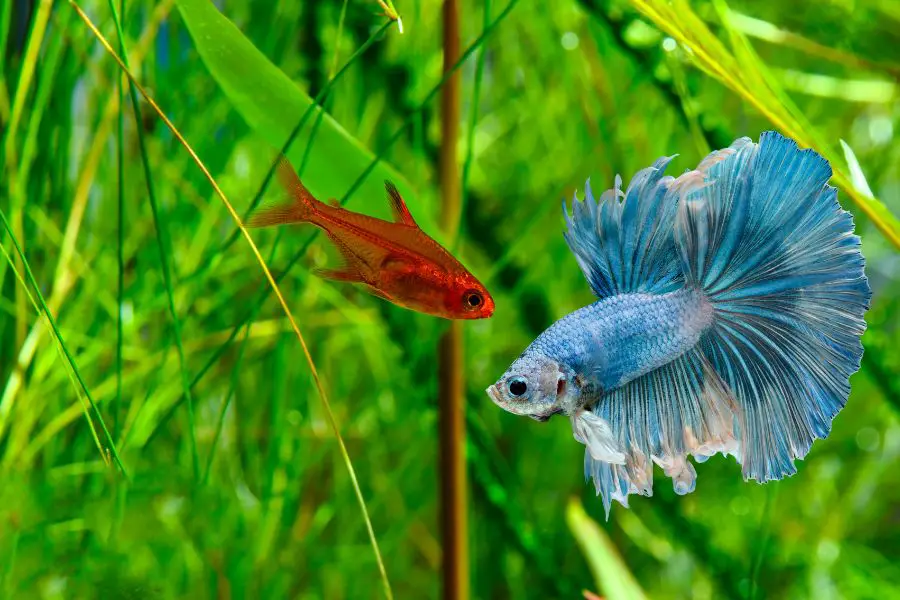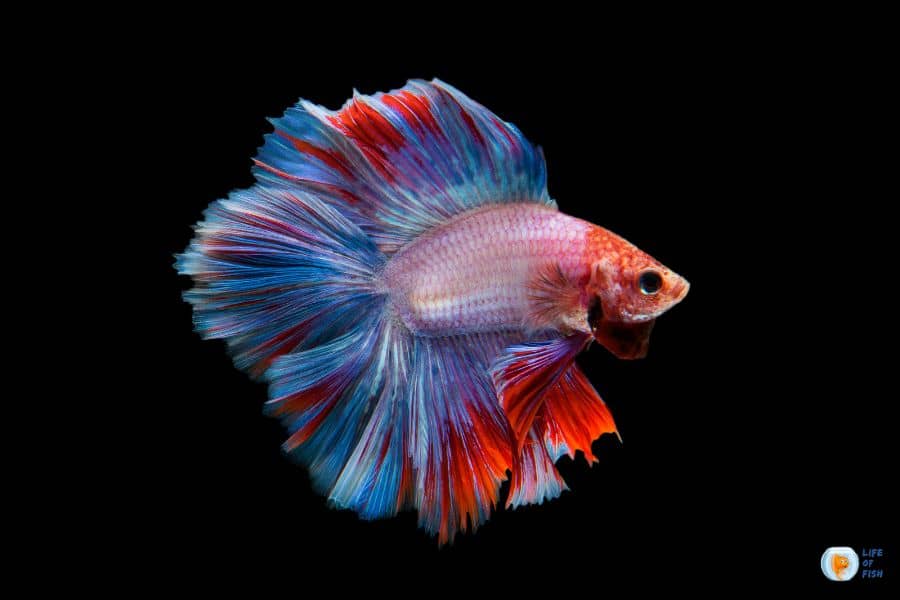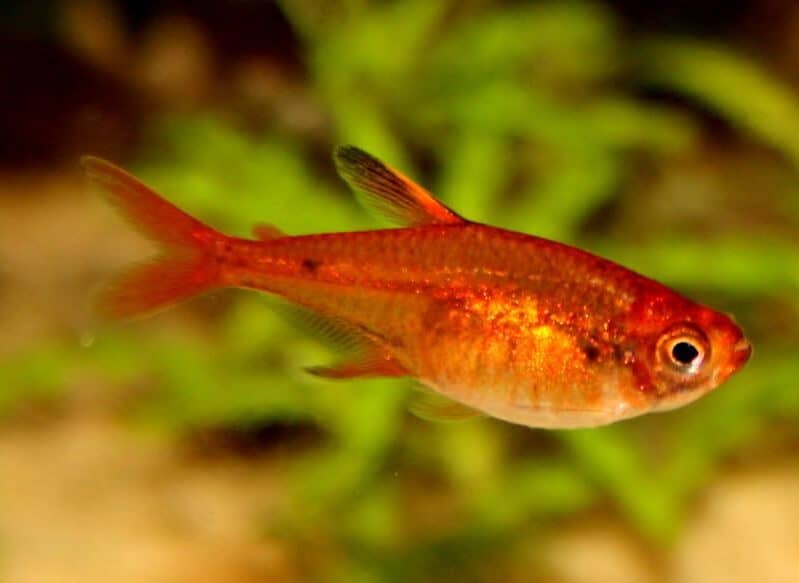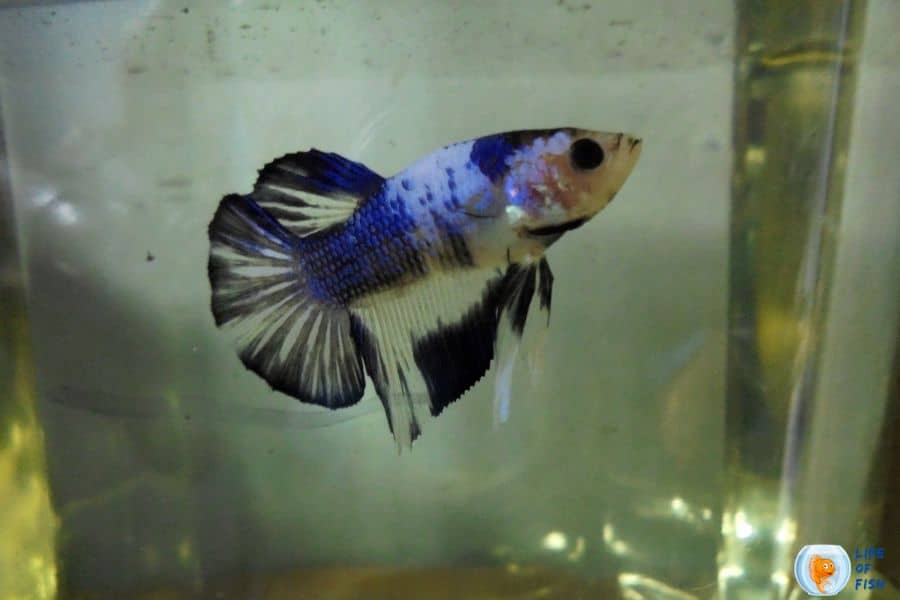The vibrant ember tetra and flashy betta fish are two aquarium favorites loved for their bright colors and active behaviors. At first glance, they seem like perfect community tankmates to combine in a shared habitat.

But can ember tetras really live successfully with aggressive male betta fish? Or will the betta’s territorial nature and likelihood to fight spell trouble for delicate tetras?
The answer is, it’s possible but challenging. With careful planning, backup options, and the right precautions, ember tetras and bettas can coexist harmoniously.
Follow this advice to create a thriving habitat where your ember tetra school and betta fish can live their best lives!
An Overview of Ember Tetra & Betta Fish Species
Jump To
- 1 An Overview of Ember Tetra & Betta Fish Species
- 2 Creating Perfect Tank Conditions for Ember Tetras and Bettas
- 3 Selecting Appropriate Tankmates for Ember Tetras and Bettas
- 4 Recommended Tank Size, Setup & Maintenance for Ember Tetras and Bettas
- 5 Feeding Considerations for Ember Tetras and Bettas
- 6 Ember Tetra Behaviors to Monitor Around Bettas
- 7 Minimizing Aggressive Behaviors in Bettas Housed with Ember Tetras
- 8 Alternate Tankmates for Ember Tetras and Bettas
- 9 FAQs About Housing Ember Tetras with Bettas
- 10 Avoiding Disaster and Achieving Success with Ember Tetras and Bettas
- 11 Peaceful Coexistence is Possible for Ember Tetras and Bettas
To understand whether two fish can make good tankmates, you first need to get acquainted with their background, origin, behaviors and care needs. Let’s briefly profile ember tetras and betta fish:
Ember Tetra Facts
- Scientific Name: Hyphessobrycon amandae
- Origin: Tributaries of the Amazon River
- Adult Size: Up to 1.4 inches long
- Lifespan: 2-5 years with proper care
- Temperament: Peaceful schooling fish
- Behaviors: Swim in tightly-knit schools for security
- Care Level: Easy for aquarists of all experience levels
- Diet: Omnivore – eats a variety of live and prepared foods
- Appearance: Translucent orange fins with shimmer

Betta Fish Facts
- Scientific Name: Betta splendens
- Origin: Rice paddies and floodplains of Southeast Asia
- Adult Size: Up to 3 inches long
- Lifespan: 3-5 years with proper care
- Temperament: Aggressive, territorial when housing with others
- Behaviors: Flare gills, spread fins to intimidate perceived rivals
- Care Level: Moderate – requires space, enrichment, alone time
- Diet: Carnivore – eats live or frozen meaty foods
- Appearance: Vibrant colors, large flowing fins and tail

Now that we understand the background of each fish, let’s look at ideal tank conditions for housing ember tetras with bettas.
Creating Perfect Tank Conditions for Ember Tetras and Bettas
While ember tetras and bettas hail from very different parts of the world, they luckily have quite similar care needs when it comes to water conditions, which makes co-habitation easier. Here are the parameters both thrive in:
- Temperature Range: 75-82°F
- pH: Slightly acidic, between 6.5-7.5
- Water Hardness: Soft to moderately hard
- Aquascape: Heavily planted with plenty of sight breaks and hides
Use a submersible heater to maintain water temperature. Introduce natural materials like driftwood, peat, oak leaves, etc to gently lower pH. Perform 25% weekly water changes.
In addition to clean, stable water parameters, tank setup also plays a key role in success when mixing these species:
Tank Size
For a group of 6 ember tetras plus one betta, aim for at least a 20 gallon tank. Bigger is always better to disperse aggression issues.
Plants & Decor
Densely plant the tank and include floating plants like hornwort to provide tetra hiding spots if chased. Leave some open areas for the betta to claim territory.
Low Flow
Minimal water movement keeps the betta calm. Use a sponge filter or low gph hang-on-back filter turned down.
Betta Hideouts
Create clear betta-only spaces and retreats with caves, tunnels and planted areas just for them.
Now that we’ve covered tank conditions, let’s look at ideal tankmates for each species.
Selecting Appropriate Tankmates for Ember Tetras and Bettas
To reduce aggression, choosing compatible tankmates is key. Here are some top options for each fish:
Great Tankmates for Ember Tetras Include:
- Other peaceful schooling fish like neon tetras, cardinal tetras, glowlight tetras, etc.
- Bottom dwellers like corydoras catfish and otocinclus catfish
- Dwarf shrimp like cherry shrimp or amano shrimp
- Snails like nerite snails or mystery snails
Great Tankmates for Bettas Include:
- Schooling fish with short fins like ember tetras, harlequin rasboras, chili rasboras
- Bottom feeders like pygmy corydoras and kuhli loaches
- Snails and shrimp (though bettas may eat smaller varieties)
- Peaceful community fish like platies, mollies, guppies, etc.
Avoid known fin nippers like tiger barbs or serpae tetras in a betta community. Also don’t mix slow-moving long-finned fish that may provoke attacks.
Now let’s get into the specifics of tank size, setup, maintenance and feeding for housing ember tetras with bettas.

Recommended Tank Size, Setup & Maintenance for Ember Tetras and Bettas
Follow these best practices when it comes to tank size, aquascaping, and regular care for keeping ember tetras together with bettas:
Minimum Tank Size
For a group of 6 ember tetras plus one betta, start with at least a 20 gallon planted aquarium. Bigger is always better when it comes to curbing aggression.
Aquascape Considerations
Include lots of tall stem plants, floating plants, and hardscape like driftwood and rock caves. Create clear betta territory and tetra schooling zones.
Leave plenty of open swimming space for both fish. Use low lighting to avoid excess algae.
Filtration & Flow
Opt for gentle filtration like a sponge filter to limit water movement. Baffle hang-on-back filters with a pre-filter sponge. Keep surface rippling minimal.
Water Changes
Perform 25-30% partial water changes weekly, or twice weekly for tanks under 20 gallons. Use a gravel vacuum to remove waste. Always condition new water to remove chlorine/chloramines.
Quarantine & Introduction
Quarantine new fish for a few weeks before introducing to observe health. When first added, temporarily divide the tank with a clear partition so fish can see each other before mingling.
Backup Tank Space
Have an alternate tank ready in case the betta shows unrelenting aggression towards tetras that requires their permanent separation.
When it comes to feeding, here are some tips to meet both fish’s nutritional requirements:
Feeding Considerations for Ember Tetras and Bettas
With different dietary needs, tailoring meals takes care and planning:
Ember Tetras
- Omnivores that accept a wide variety of foods
- Offer a small amount 2-3 times per day
- Flake foods, micro pellets, brine shrimp, bloodworms, daphnia
- Remove uneaten food promptly
Bettas
- Insectivores prefer meaty, protein-rich foods
- Feed just 2-3 pellets or frozen foods once or twice a day
- Let pellets soak before feeding to prevent bloating
- Target feed frozen bloodworms, brine shrimp using pipette or tweezers
When housing together, take care to prevent the tetras from stealing the betta’s food, which can lead to aggression. Monitor all feedings closely.
Now that we’ve covered the tank setup and care basics, let’s go over ember tetra behaviors to watch for when keeping them with bettas.

Ember Tetra Behaviors to Monitor Around Bettas
Ember tetras are peaceful fish when kept in proper sized schools in larger tanks. But some natural behaviors can provoke aggressive reactions from bettas:
Tight Schooling
If tank space is inadequate, tight schooling can resemble a threatening shoal of fish to territorial bettas. Give them room to loosely group and lazily swim.
Investigative Nipping
Nipping at long betta fins can occur, especially if tetras are underfed. Keep their attention focused on each other, not the betta.
Shimmering Highlights
While beautiful, their iridescent shine is meant for communication within their school. But it may look to a betta like flashing or flaring.
Skittish Darting
Their natural skittishness and sporadic movements may resemble prey to a betta, triggering predatory attacking behavior. Provide ample plants and hides.
Surface Gulping
Tetras occasionally going up for air can seem to a betta like an invasion of its territory. Break the surface tension with floating plants.
Even with preventative steps, betta aggression is still a risk. Let’s go over ways to curb bullying and attacks from bettas towards tetras sharing their environment.
Minimizing Aggressive Behaviors in Bettas Housed with Ember Tetras
Despite ideal conditions, bettas may still show some hostility towards tetras. Here are some tips to discourage aggression:
Select Placid Bettas
Avoid excessively combative bettas, like king bettas. Female bettas or short-finned plakats are less prone to fighting compared to showy males.
Limit Visual Triggers
Lower water level a few inches to reduce what the betta sees. Block line of sight with plants and hardscape. Limit reflective or transparent tank sides.
Re-arrange Tank Weekly
Shift plants, rocks and ornaments to break up territorial attitudes before they develop. Create new visual barriers and domains.
Reduce Tank Lighting
Excess light aggravates aggression and flairing. Use low wattage or float plants to dim illumination and block the view.
Have Backup Plans In Place
Be prepared to add more hides, rehome fish, or separate the betta should relentless attacking occur despite preventions.
Even in ideal conditions, the betta’s combative nature may prove incompatible with ember tetras. So it’s smart to have backup stocking ideas on hand.
Alternate Tankmates for Ember Tetras and Bettas
If ember tetras and bettas show signs of persistent incompatibility in your aquarium, don’t lose hope! Here are some alternate tankmate options better suited to each species’ temperament:
Alternatives for Ember Tetras Include:
- Other small tetra species like neon tetras, glowlight tetras, flame tetras, etc.
- Rasbora fish like harlequin rasboras, chili rasboras, etc.
- Small peaceful barbs like cherry barbs, gold barbs, etc.
- Corydoras catfish and otocinclus algae eaters
- Snails like nerite snails or mystery snails
Alternatives for Bettas Include:
- Larger schooling fish with short fins like rummynose tetras
- Armored bottom dwellers like corydoras or bristlenose plecos
- Dwarf cichlids like scarlet badis or ram cichlids
- Shrimp and snails (though bettas may prey on smaller varieties)
- Peaceful community fish like mollies, platies, swordtails, etc.
Do your research to pick tankmates with similar care needs and temperaments as either ember tetras or bettas. Introduce any new additions slowly.
Now let’s wrap up with some frequently asked questions about this combination:
FAQs About Housing Ember Tetras with Bettas
Some common questions that come up when considering this mix include:
Are ember tetras fin nippers?
Healthy, well-fed ember tetra schools are not prone to excessive fin nipping. But insufficient tanks or schools can lead to nippy behaviors and fin damage.
How many ember tetras can live with a betta?
Aim for at least 6 ember tetras so they feel secure schooling together. 10-12 embers is even better to reduce aggression. Add them before introducing any bettas.
What size tank do ember tetras need with bettas?
For a group of 6 ember tetras plus one betta, start with a 20 gallon heavily planted tank. Bigger is always better to disperse aggression when mixing species.
Do bettas eat ember tetras?
Directly consuming ember tetras is unlikely, but bettas may kill them. Close supervision is required, especially during feeding times when aggression peaks.
Should I get a male or female betta for ember tetras?
Female and short-finned male bettas like plakats are less aggressive. Avoid extra-combative male varieties like crowntails and king bettas.
Avoiding Disaster and Achieving Success with Ember Tetras and Bettas
Here are some key dos and don’ts when attempting to mix ember tetras and bettas:
Do:
- Provide a 20+ gallon heavily planted tank
- Use calm tankmates with similar water needs
- Add the tetra school before introducing any bettas
- Have backup tank space ready in case of aggression
- Monitor all fish closely, especially during feeding
Don’t:
- Attempt to co-house in anything smaller than 20 gallons
- Skimp on plants, hides, and sight breaks
- Combine fin-nippers like tiger barbs with bettas
- Let water quality deteriorate even slightly
- Overfeed or feed live foods that trigger aggression
Peaceful Coexistence is Possible for Ember Tetras and Bettas
While challenging at times, keeping ember tetras together with betta fish can result in a beautifully balanced freshwater community aquarium.
With ample research, plenty of planning, a well designed tank, and contingency strategies in place, this mix can thrive. Paying close attention to each fish’s behaviors and being prepared to tweak or separate them allows these striking species to coexist.
We hope this guide has provided you with the key facts and advice to successfully house ember tetras with bettas. Let us know if you have any other questions!
Compatibility Guide: Keeping Neon Tetras with Betta Fish
Rare Betta Fish: Understanding Their Genetics and Traits
Dragon Betta / Dragon Scale Betta Care – With Buying Guide
